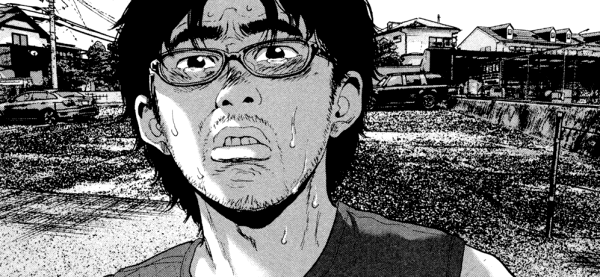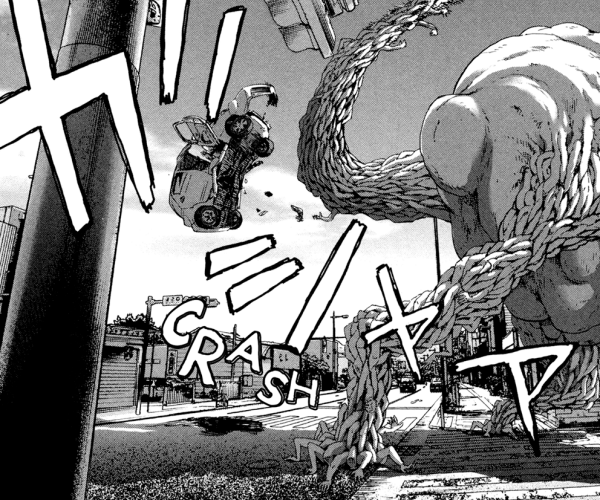Kengo Hanazawa’s manga I Am a Hero ended just the other day, after eight years of publication. The ending has divided readers—understandably so—as it leaves many questions unanswered, but I don’t believe it’s as open as it seems.
Warning! Spoilers below.
After the showdown atop the Sunrise building in Tokyo, a group of survivors manage to escape via the helicopter. It’s shown later that they land on the Izu Shichito islands off the coast of Tokyo, which are seemingly unaffected by the zombie apocalypse. Meanwhile, Hideo is engulfed by the monstrous hive mind, but is spared by Hiromi. Thereafter, the hive mind and—presumingly—the Kurusu conglomerate become idle after deciding to spare the final remnants of humanity in Tokyo. Hideo is then left to fend for himself in a post-apocalyptic world, where he believes he is the only survivor.

Hideo lives out his days alone, ransacking supermarkets for food and eventually cultivating a small farm. He converses with statues and road signs, but is otherwise sane and healthy, transformed from the beginning of the manga where he was afraid of the dark and experienced numerous delusions. During an earthquake in the penultimate chapter, he even calls out for his imaginary friend Yajima, but he doesn’t appear.
In the final pages, Hideo locates a gun shop and begins making ammo for his rifle, after his crops are eaten by a herd of deer. At some point during this chapter—or perhaps even before—there appears to have been a significant time-skip, as Hideo is shown to be balding when he removes his cap. After shooting, skinning and butchering a deer, he is then shown in winter, tracking a boar, after which the manga ends.
I can sympathise with the dissatisfaction surrounding this ending, as it leaves many aspects unexplained. I Am a Hero is a fantastically involved work, which spanned many years, featuring numerous characters in varied locations — at one point even jumping across the ocean to Europe to depict the pandemic in foreign territory. Naturally, readers expected some sort of conclusion to all the threads and pieces of information we were fed throughout the series.
However, the story had always been about Hideo and his place within the world. When the author took a step away from Hideo, it was more to do with world building and development than it was to introduce new character arcs and plot points. Not everything is essential to the overarching plot and by leaving many aspects vague, Hanazawa was able to maintain a terrific sense of allure and wonder throughout. Also, by building towards a conclusion for Hideo but leaving much of the rest up to interpretation, he breathes a sense of authenticity and perpetuation into the world of the manga.

Hideo is a detached character whose life before the pandemic was full of dissatisfaction and emptiness. He wants to be somebody, but he doesn’t have the gumption to try. In the final pages, he laments over these times and ponders what the point of his life was. He had a comfortable routine, but no direction and a bleak future. Now, he is attuned to survival. He has grown from a pathetic, bumbling man-child to self-sufficient hunter, thanks to the numerous ordeals and situations the ZQN have forced him through. He is alone, but he is able to grasp his existence. Finally, he can exclaim: “My life — bring it on.”
The problem with zombie series—especially those that span a lengthy period—is that, naturally, audiences want to know the origins of the world. How did this happen and why? Hanazawa weaves so many fantastical elements into his work, from mutated people to magnificent clusters made from the bodies of thousands of former humans. These aspects are fascinating and it’s difficult not to ponder their place within the story.
- Why did that walking head turn into a tree?
- What the heck is up with those weird things in Barcelona?
- What happened to the man on the boat?
- What motives did the ZQN have?
There’s a lot more the author could have concluded, but those things don’t matter to Hideo’s story and it’s important to have focus as a writer. Hanazawa never once became lost in his creation and the ending—while it may feel deflated and incomplete given the potential scope of the story—is the most natural for Hideo’s progression.
I Am a Hero is about the small lives of ordinary characters in an extraordinary world. The author delved into this in a Manben episode, explaining how he likes to draw Hideo and the other main characters as part of the background rather than the foreground in order to paint them as ordinary people — quiet members of society who don’t stand out.
Hideo is wonderfully written and his psyche tremendously explored, with the author touching upon themes of introversion, alienation, loneliness, courage and dreams. If you think about the manga in terms of Hideo and his singular place within humanity—as one man’s growth through adversity—rather than an all-encompassing zombie saga, it is far more fulfilling.


I saw the final chapter to I Am A Hero a few days ago, since then I’ve been puzzled on what to think about it. Reading this has helped me make up my mind about it, and I’m happy to say I like the ending quite a bit more now. Thanks!
LikeLiked by 1 person
Hi David! Thanks for your comment. Glad to have helped you reach a conclusion regarding the ending. I was a bit sour towards it at first, too. It’s certainly understated, but I don’t think the manga was ever destined for a grand ending. It was Hideo’s journey, with the author building a vast and detailed landscape along the way, through some rich subplots and amazing imagery. Though he remains alienated, I am glad Hideo was able to become a ‘hero’ in his own eyes come the end and that the progression felt very authentic.
LikeLike
>Hanazawa never once became lost in his creation
Fuck you. What was EVERY Italy chapter if not exactly that? Why build up all these mysteries that have ABSOLUTELY NOTHING to do with the main character if he’s gonna drop every single one of them? Reading the last ~50 chapters, its clear that the art was going down the shitter and he no longer cared about his own story. Once his boredom reached a peak he just lopped off the story in the most lazy manner conceivable. There is absolutely nothing worth defending here.
LikeLike
The Italy chapters were to establish that the ZQN were in search of a ‘Queen,’ which is what Hiromi became to the horde in Japan. It also shed more light on the Kurusu phenomenon. Just as the chapters in Barcelona displayed how the ZQN had evolved beyond a brainless swarm to attain some degree of community and design. I think it was great Hanazawa took a step back from the main action to develop the plot and it’s ideas elsewhere. So many other series that deal with global themes tend to lose their authenticity when they set the action solely in Japan, such as Platinum End. It also allowed him to attain a natural pace and develop the supporting cast, all of whom were massively central in the climatic arc. I think it’s true the art style wasn’t as alluring as early on, and Hanazawa seemed to adopt a more digitised approach, but it was by no means poor, and it seemed clear to me that he was building to this conclusion. All the pieces are there. No need to act like a total asshole when you disagree with somebody, or if you can’t work out the plot.
LikeLike